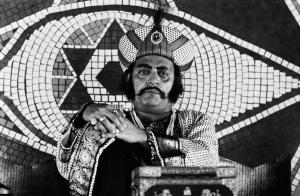The Onus is Now on the Leader Himself
Is maximum governance feasible under minimum government?
As he savoured the sweet taste of a journey that has taken him all the way from the crimsoned streets of 2002 to an arresting ceremony on the forecourt of Rashtrapati Bhavan on Monday, PM Narendra Modi could be forgiven for wondering whether the road from here on is likely to be just as tortuous.
His pre-swearing-in statement spoke of “minimum government, maximum governance” and a new paradigm of hyper-efficient administration. But with some exceptions, the parade of faces that made up his Council of Ministers were a throwback to an earlier era and seemed so out of sync with the idea of ‘smart governance’ that even die-hard Modi supporters found it hard to contain their disappointment. The fact that several ministers have criminal cases pending against them or question marks over their efficiency or even integrity has contributed further to that sense of déjà vu.

Photo courtesy: Hirak Rajar Deshe
At the apex, of course, the generational shift is both visible and welcome. The articulate and highly capable Sushma Swaraj will make an excellent external affairs minister. Modi’s choice of Arun Jaitley as finance minister has been widely applauded by the corporate sector. Though Rajnath Singh as home minister rounds off the Cabinet Committee on Security, the absence of a full-time raksha mantri is a glaring omission that simply cannot be squared with the BJP’s campaign promises of strengthening India’s defences and modernizing its armed forces.
Much has been made of the “no ministers over 75″ rule that Modi appears to have imposed, thereby knocking out party stalwarts like Murli Manohar Joshi or Yashwant Sinha from consideration. But his inability to find a suitable minister for the crucial defence portfolio from amongst the BJP’s younger generation of leaders suggests either talent — or trust — is at a premium in the new dispensation.
Taking a leaf from the 2009 Administrative Reforms Commission report that envisaged a maximum of 20-25 super ministries, Modi did well to combine associated portfolios and place them under the charge of a single minister. Urban Development will now be handled by the same minister in charge of Housing and Urban Poverty Alleviation. Rural Development has been clubbed with Panchayati Raj and Drinking Water and Sanitation. Shipping is back with Surface Transport and Overseas Indian Affairs with External Affairs. Of course, care has to be taken to ensure this experiment doesn’t end up having an effect opposite to the one intended, if, as is likely, ministerial files pile up or are dispatched with undue haste.
Having raised expectations of a leaner, fitter establishment, Modi was careful to keep his first tranche of ministers to 45. In comparison, Manmohan Singh bowed out with 69 ministers in tow while Atal Bihari Vajpayee’s outgoing council of ministers had 77 members. As he settles down to the business of government, however, the PM will soon realise the need for additional numbers. The MEA, for example, needs two full-time ministers of state. Nirmala Sitharaman, who has been giving independent charge of the equally intensive commerce and industry portfolio, will not only have no junior minister to share some of the burden but is expected to double up as an MoS for finance and company affairs.
The combination of power and coal is sensible, but Piyush Goyal, the minister who has independent charge of both these big portfolios, will have no deputy and must also look after new and renewable energy — a portfolio so strategic in the long run that it deserves a dynamic minister of its own. And while the Congress has unfairly targeted the new Human Resource Development minister, Smriti Irani for not being a graduate, the fact that no MoS has been assigned to this huge and complex ministry has gone virtually unnoticed.
In the absence of an optimum number of ministers, the business of government in some ministries will end up being handled by rule-bound, risk-averse bureaucrats. Modi’s plan may be to crack the whip from the PMO — he has included “all important policy issues” among his own responsibilities — but this is easier said than done. While the Prime Minister’s first priority will be to give a push to stalled infrastructure projects, a recent taxonomy by the Financial Times indicates at least half of these are stuck because of problems at the state level while many, especially power projects, have run into intractable legal disputes — like those over coal and gas pricing — that cannot be resolved by fiat.
Simply put, Modi’s challenge is this: he fought and won a presidential-style election promising helmsmanship of mythic proportions, but the system he now heads is parliamentary not presidential, federal not unitary. The only way to square the circle is to rely on executive authority: diktats, directives and Ordinances. It is not a good omen that one of Modi’s first decisions as PM has been to issue an Ordinance to amend the Trai Act to remove the bar placed on future government employment for Trai chairmen and members, so that Nripendra Misra can be appointed his principal secretary. With the stroke of a pen, a message has been sent to all “independent” regulators: if you scratch our back, there’s no limit to how far we can go to scratch yours.
Courtesy: svaradarajan.com
(The writer is Senior Fellow, Centre for Public Affairs and Critical Theory, Shiv Nadar University)
Disclaimer: The views expressed here are the author's personal views, and do not necessarily represent the views of Newsclick
Get the latest reports & analysis with people's perspective on Protests, movements & deep analytical videos, discussions of the current affairs in your Telegram app. Subscribe to NewsClick's Telegram channel & get Real-Time updates on stories, as they get published on our website.
























